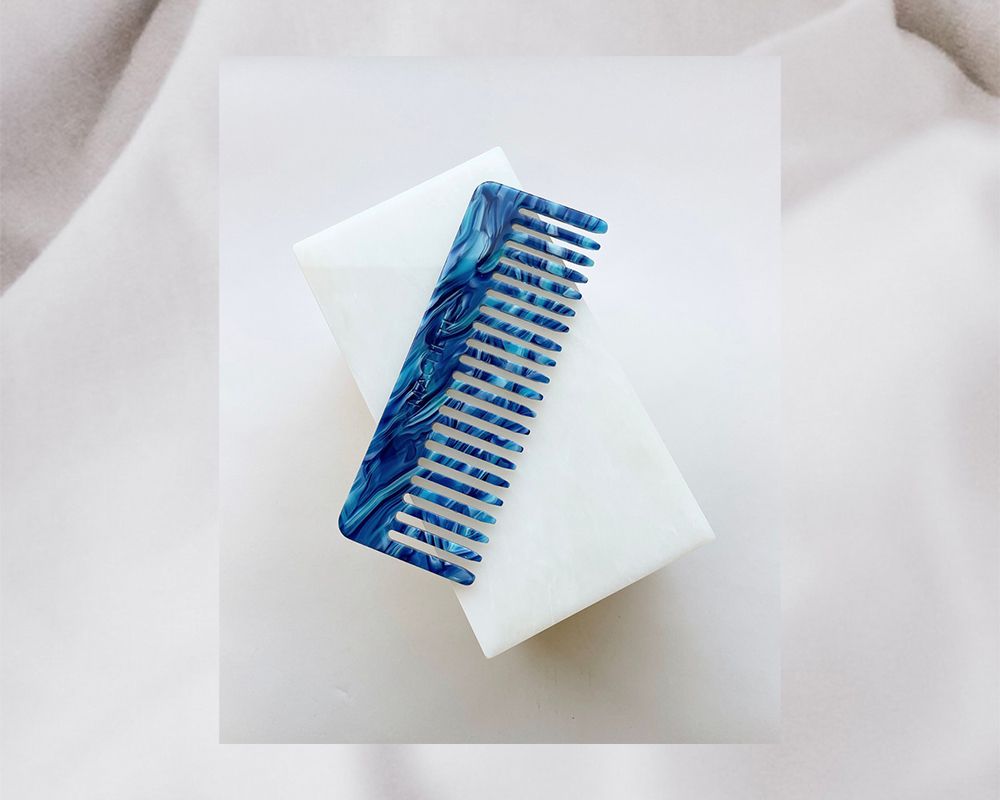Few people can escape the horrors of knotted hair—the babies, the balding, and the buzz-cutters are pretty much the only ones safe. For the rest of us, knots are an unfortunate part of life.
While a good detangler and hair brushing can usually fix your everyday tangles, sometimes those knots and tangles take on a life of their own. In those situations, we’re faced with the upgrade no one asked for: What were once simple knots and tangles become deeply intertwined, lumped together mats. And matted hair is no joke.
While your first thought might be to grab the scissors, fight that instinct. With the right tools and temperament, it’s possible to get rid of mats from your own home. Read on for advice from hair health expert Shab Reslan and trichologist Bridgette Hill on removing mats and how to avoid matted hair altogether.
Meet the Expert
- Shab Reslan is a hair health expert, hairstylist, and host of the Hair Like Hers Podcast.
- Bridgette Hill is a certified trichologist and founder of Root Cause Scalp Analysis, as well as a member of invisibobble’s Hair Loving Task Force.
What Causes Extremely Matted Hair?
Matted hair is a combination of attached and shed strands that twist together to form clumps—think traditional knots and tangles, but worse. While everyday knots can be removed fairly easily, mats are tough, if not altogether impossible, to remove with a brush or comb alone.
Hill describes matted hair as “hair fibers that become intertwined around each other in a tight interlocking pattern that become fused together, creating a cluster or clusters of an unorganized mass of hair fibers.” And while those with drier or textured hair types, like curls and coils, are certainly more prone to matted hair, it can really happen to anyone.
The number one cause of hair matting, according to Reslan, is product buildup on the hair shaft from styling products, improperly shampooed hair, conditioner or hair masks left in for too long, and the like. Over time, that buildup eventually makes hair so dull and coated that strands easily tangle together due to the ensuing friction.
Hair can also become matted from a lack of hair brushing, combing, and other detangling methods, Hill mentions. When tangled, hair fibers lack moisture and can become intertwined, eventually leading to mats. Other causes include improper use of hair accessories or hair ties, long stints without trims, and failure to protect hair overnight.
How to Detangle Extremely Matted Hair
Here’s the good news: Cutting matted hair is the absolute last resort. That being said, Hill warns that the key to detangling extreme mats is having patience—and being prepared with the proper tools. As for the tools, she suggests the following:
- Wide-tooth comb
- Detangling brush
- Pin-curl or rat-tail comb
- Detangling primer (her pick: Oribe’s Run Through Detangling Primer, $37)
- Detangling spray (her pick: R&C’s Pinstripe Intense Detangling Spray, $26)
- Hair oil (her pick: Karite’s Nutri-Nourishing Oil Treatment, $40)
- Moisturizing conditioner or treatment
- Invisibobble’s Traceless Waver Hair Pins ($4)
Once you’ve rounded up your tools, you’re ready to begin the process.
- Saturate the entire matted clump with detangler spray, using your fingers to really disperse the product throughout the mass of hair.
- Using your fingers, try to gently loosen up the hair fibers—make sure the hair is completely covered with the detangler spray.
- Apply oil to the hair mass for some additional lubrication and slip. This will allow you to safely comb through the hair as you try to separate the hair fibers from one another. Use the wide-tooth comb for this step.
- Isolate any free-hanging hair strands. Work a detangling brush from the bottom of the hair, moving slowly and carefully up toward the matted area.
- Alternate between the detangling brush, wide tooth comb, and rat-tail comb as needed based on their effectiveness in loosening the tangles in the matted area. For tightly intertwined areas, use the end of an Invisibobble Waver to isolate hairs from the mass.
- As hair becomes isolated from the mass, use the wide-tooth comb to remove any loose hairs in the mat. Add conditioner to those ends for extra moisture and protection. Proceed with the above steps until the mat is fully removed.
In extreme cases, Hill suggests beginning with the oil and saturating the matted clump using your fingers. Begin in the middle of the mat and attempt to loosen and widen the mat to find some loose ends of hair to work with. Hill says using the tail of a pin-curl comb is especially helpful in this case, as it will create space to work through the mat. Then proceed with the steps as stated before.
Keep in mind that it’s fairly normal to see some hair shedding during the detangling process since mats consist of hairs you’ve already shed.
When to Cut Your Hair
If you’re unable to get a comb (or even the tail of a comb) into the mat, cutting is unfortunately your only option. Alternatively, if you find yourself tugging on hair fibers and creating too much tension, it also might be time to get out the scissors.
If it’s been weeks or months since you last combed your hair (we don’t judge), cutting might also be your best option since it will likely take many hours to fully detangle mats—and even then, results aren’t guaranteed.
How to Avoid Extremely Matted Hair
Congratulations: You’ve successfully de-matted your hair. Now you want to avoid future mats. The key here, according to Hill, is practicing proper scalp and hair care, using accessories designed to prevent tangles and snags, keeping the ends of hair hydrated with a light serum or leave-in treatment a few times a week, and scheduling regular haircuts. For long hair, or hair prone to knotting, consider protecting your strands at night with a silk pillowcase, scarf, or bonnet.
Be mindful of hairsprays and backcombing, both of which encourage tangling and matting of hair fibers. And, of course, make sure to detangle hair thoroughly after every wash.
The Final Takeaway
Matted hair is an absolute pain to deal with, even with the right tools and techniques. In an ideal world, we’d avoid matted hair altogether, but we know this isn’t the case. Life happens, mats happen.
Luckily, the right tools and techniques—and a whole lot of patience—can most likely save you from a major chop. So find your inner peace, grab a great comb, and get to de-matting.
FAQ
-
What is matted hair?
Matted hair is a combination of attached and shed strands that twist together to form clumps. While everyday knots can be removed fairly easily, mats are tough, if not altogether impossible, to remove with a brush or comb alone.
-
How does matted hair occur?
The number one cause of hair matting is product buildup on the hair shaft from styling products, improperly shampooed hair, conditioner and hair masks left in for too long, and the like. Over time, that buildup eventually makes hair so dull and coated that strands easily tangle together due to the ensuing friction. Hair can also become matted from a lack of hair brushing, combing, and other detangling methods.
-
Who can get matted hair?
Anyone with hair can get matted hair—even dogs. That being said, those with drier and more textured hair types tend to be more prone to mats.
-
How can I avoid matted hair?
The key is practicing proper scalp and hair care, using accessories designed to prevent tangles and snags, keeping the ends of hair hydrated with a light serum or leave-in treatment a few times a week, and scheduling regular haircuts. For long hair, or hair prone to knotting, consider protecting your strands at night with a silk pillowcase, scarf, or bonnet.
Truth: These Are the Best Detangling Brushes We’ve Ever Used










